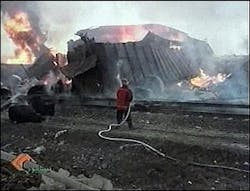Iran Leader Orders Probe Into Train Blast
Relatives of the victims were allowed close to the explosion site for the first time since the runaway train cars exploded at dawn Wednesday, killing 320 people, injuring 460 others and damaging five villages. The provincial governor said negligence or brake failure probably caused the accident.
The station nearest this small village of 400 people was still standing, though walls were damaged, windows were broken and nearby trees had fallen. Smoke was still rising from the site of the explosion and bulldozers and rescue workers continued clearing the area, removing debris and looking for body parts.
At least four trains passed through the devastated village Friday on two miles of new track, local railway official Majid Asgarian said. Passengers on one train gathered by the windows, some taking pictures of the ruin.
Khatami on Thursday called for an extensive probe into the causes of the derailment in this northeastern village 400 miles east of Tehran.
Speaking in Tehran, the president expressed deep regret for the loss of life and ordered that ``full light be shed'' on the causes of the train derailment.
The train, with no one on board, was loaded with gasoline, fertilizer, sulfur and cotton when it somehow started rolling out of a rail yard before dawn Wednesday. It traveled 31 miles before hitting a sharp turn at the next station. All but three cars derailed, with some catching fire.
The wrecked train burned for more than five hours before its hazardous cargo exploded, killing firefighters, rescue workers, spectators and villagers. The blast collapsed mud homes in five villages, shattered windows as far as six miles away and left a crater 50 feet deep.
Rescue officials and railway workers who battled the fire were aware of the hazardous cargo but did not realize that the blaze caused some freight cars to heat up to the point of combustion.
A provincial official said Thursday two possible causes of the crash were being investigated.
``One ... is negligence of the personnel at the station and the other is technical failure of the braking system,'' said Hassan Rasouli, governor of Iran's northeastern Khorasan province.
An iron wedge used on Iranian trains to secure the wheels of the lead car was broken and it was unclear if brakes on individual cars were working, Rasouli said.
The train's cargo was on the way from central Asian countries to Iran's southern port of Bandar Abbas, Rasouli said.
Railway station managers in the city of Neyshabur were called in for questioning as the investigators prepared an accident report, said Asgarian, the local railway official.
The explosion killed Mojtaba Farahmand-Nekou, the governor of Neyshabur, the fire chief and other rail and city officials, further complicating the investigation.
On Thursday, residents in the village grieved for their loved ones.
``I don't want to live, I have lost everything,'' a sobbing Hossein Ghassemabadi, whose son and daughter-in-law were killed.
Many people in the area complained of sore throats from the fumes and experts were dispatched to determine the potential health hazards, Rasouli said.
Related:
